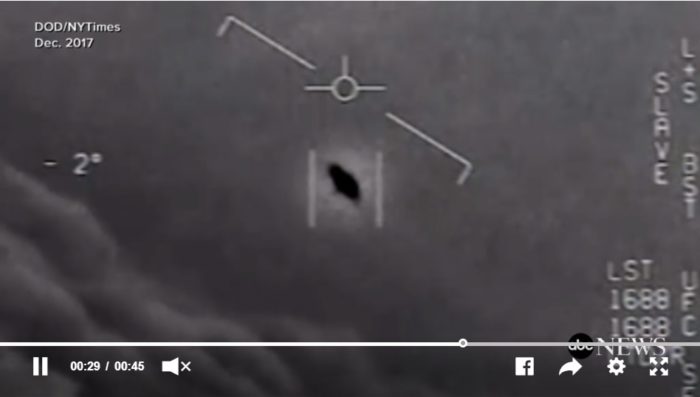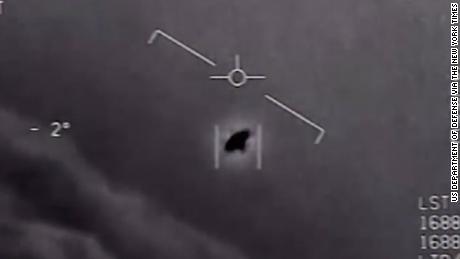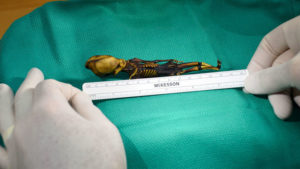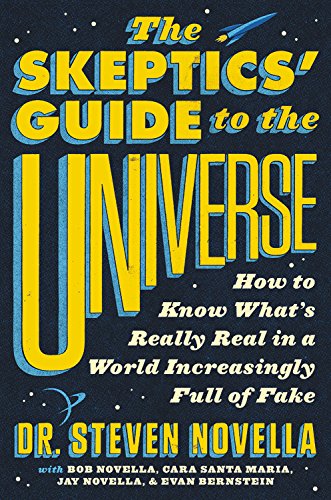Apr
28
2020
 Several alleged UFO videos have been circulating for the last few years, and now the Pentagon has officially released them, in order to dampen public speculation about their authenticity. There is now no question that the videos are genuine Navy videos of unidentified aerial phenomena (UAP). But of course, the core questions remains – what are they?
Several alleged UFO videos have been circulating for the last few years, and now the Pentagon has officially released them, in order to dampen public speculation about their authenticity. There is now no question that the videos are genuine Navy videos of unidentified aerial phenomena (UAP). But of course, the core questions remains – what are they?
The temptation, of course, is to leap from “unidentified” or unknown to “alien.” As I have discussed before, this also happens with astronomical observations, although professional astronomers tend to be more cautious. Every time we encounter a previously unknown astronomical phenomenon (starting, famously, with pulsars that were originally nicknamed LGMs for “little green men”) someone speculates if we can be seeing an alien artifact. So far the answer has been no.
The Pentagon has a program, previously secret but now acknowledged, to seek out, document, and examine UAP. The concern was not alien visitors, but foreign technology. Do the Russians have spy drones we might want to know about? Or perhaps we can detect testing of new weapons. Out of this program, these three released videos emerged. So let’s step back and ask the question everyone wants to ask – what is the probability that one or more of these videos represent alien technology visiting the Earth? I would argue that the answer is – extremely low.
Part of the reason for this answer is that rare things are rare. So far we have no confirmation that aliens are on or near the Earth. We have no confirmation that alien technological civilizations exist within feasible travel range to the Earth. They have not made their presence known, and there isn’t a single piece of objective or undeniable evidence. So the chance that some unknown phenomenon represents a specific, new, and unlikely phenomenon is inherently unlikely. This factor is often neglected, especially by believers. What are the odds that that indistinct blob verifies your specific beliefs?
Continue Reading »
May
02
2019
 The Navy recently drafted new policies for how its pilots and other personnel should report any encounters with “unexplained aerial phenomena” – more commonly known as unidentified flying objects, or UFOs. They say this is in response to an uptick in pilots reporting such encounters and requesting a formal way to report them.
The Navy recently drafted new policies for how its pilots and other personnel should report any encounters with “unexplained aerial phenomena” – more commonly known as unidentified flying objects, or UFOs. They say this is in response to an uptick in pilots reporting such encounters and requesting a formal way to report them.
The reporting on this topic ironically reveals the underlying problem in the first place – there is a stigma attached to the reporting of UFOs because of their cultural association with claims that they are (or may be) alien in origin. People mentally equate UFO with flying saucer (a colloquial term for any alien spacecraft of any shape).
Even sober takes on this topic focus heavily on the probability that such sightings are an alien phenomenon. Tyler Cowen does touch on many possible interpretations of UFO sightings, but spends the bulk of his commentary exploring how probable it is that aliens are visiting. He concludes it is not likely, but the chance is non-zero and deserves to be explored.
While I basically agree, I still think the framing is problematic. Essentially we are taking a phenomenon that likely has multiple causes, some known and some unknown, and focusing most of our attention on what is probably the least likely unknown possible cause. This would be like defining a new clinical syndrome by the least likely possible disease that could be causing it. This constrains our thinking, and in this case creates an unfair stigma. It also fuels conspiracy theories and wild speculation by the public. An further, it has resulted in paying too little attention to a phenomenon that may have practical real-world implications.
Returning to the medical analogy – there are fake diseases in the popular culture used to explain very real symptoms. For example, some people with chronic skin symptoms think they have a bizarre form a parasitosis. They clearly don’t, but that should not cause us to be dismissive of everyone with the same symptoms, or to ignore the search for underlying real causes.
Continue Reading »
Sep
28
2018
 I have long maintained that one of the greatest scientific questions for humanity is – are we alone in the universe? How common is life, and how common are alien technological civilizations? When we finally reach out into space, will it be empty for us to inhabit, or will we quickly encounter a galactic civilization? What will alien intelligent species be like, and what will that tell us about ourselves?
I have long maintained that one of the greatest scientific questions for humanity is – are we alone in the universe? How common is life, and how common are alien technological civilizations? When we finally reach out into space, will it be empty for us to inhabit, or will we quickly encounter a galactic civilization? What will alien intelligent species be like, and what will that tell us about ourselves?
It is unfortunately likely that we will not have any real answers to any of these questions anytime soon. But that does not mean we shouldn’t look. Recently NASA held a workup to explore possible avenues of looking for alien technosignatures – signs of advanced alien civilizations that we can see from Earth. Some of the participants also held a Reddit AMA.
So – what are alien technosignatures and how can we find them?
The most basic type is radio signals. There has been an effort to listen for alien radio signals for decades, often referred to as SETI, the Search for Extraterrestrial Intelligence. The idea is that radio signals are a convenient way to communicate across lightyears, and perhaps an alien world is sending out such signals for others to find. But really, we have been looking for radio signals because we can. It’s like the person looking for a lost item under a lamp post, not because they have any reason to find it there, but because the light is good.
Continue Reading »
Sep
21
2018
 You know, investigating can be difficult. There are many pitfalls, and it is easy to fool yourself, even when others are not trying to fool you. Critical thinking skills are indispensable to any investigative endeavor – along with specific domain knowledge.
You know, investigating can be difficult. There are many pitfalls, and it is easy to fool yourself, even when others are not trying to fool you. Critical thinking skills are indispensable to any investigative endeavor – along with specific domain knowledge.
Case in point – the mysterious case of the Croydon Cat Killer. For three years the mystery mutilator killed pet cats, eviscerated them, removed their heads and tails, and deposited the remains on display. Tabloids warned that the perpetrator would likely soon move onto humans. Veterinary pathologists and the metropolitan police were flummoxed. PETA offered a reward, and detectives from South Norwood Animal Rescue and Liberty (SNARL) found evidence of human involvement.
Investigators even worked up a profile of the likely suspect (40, male, problems with women, etc.).
Continue Reading »
Mar
26
2018
 In 2016 Steven Greer released his documentary, Sirius, which tries to make the case for a deep conspiracy to hide the truth of aliens and free energy. Part of the documentary was to showcase possible evidence for aliens, including the Atacama desert mummy, a six-inch mummy of what appears to be a malformed fetus.
In 2016 Steven Greer released his documentary, Sirius, which tries to make the case for a deep conspiracy to hide the truth of aliens and free energy. Part of the documentary was to showcase possible evidence for aliens, including the Atacama desert mummy, a six-inch mummy of what appears to be a malformed fetus.
Greer and other UFO enthusiasts thought the mummy looked like an alien, with its cone-shaped head and strange anatomy. There are certainly a lot of anomalies to point to in the mummy, but just pointing to anomalies does not result in scientific conclusions. The documentary takes pains to point out that the mummy is not a crafted hoax, but the remains of a living creature. This is true, but misses the real criticism of the alien hypothesis. It is the remains of a living human.
Recently DNA analysis of the mummy found that it was indeed human. And now further analysis shows that it was a human female of mixed heritage with many newly found mutations in genes that code for bone proteins. The mummy itself is probably only decades old, as the DNA was well-preserved.
These results are not surprising, and we may learn something about genetic bone disease from studying the effects of the newly discovered mutations.
Continue Reading »
Dec
19
2017
 I am not impressed. That is often the reaction I have to hyped reports of alleged evidence for strange phenomena. They never turn out to be truly impressive or exciting. The recently released Pentagon UFO videos are no different.
I am not impressed. That is often the reaction I have to hyped reports of alleged evidence for strange phenomena. They never turn out to be truly impressive or exciting. The recently released Pentagon UFO videos are no different.
The backstory is that it was recently revealed that the Pentagon funded the Advanced Aviation Threat Identification Program for five years with a total of $22 million. The program officially ended in 2012 but apparently its members continued to investigate interesting reports off the books. The former director of this program, Luis Elizondo, pushed to have some of the evidence they uncovered made public, resulting in the release of the video.
Elizondo is a believer. He is quoted as saying:
“I think this is a national security imperative,” Elizondo said. “We have clear things that we do not understand how they work, operating in areas that we can’t control.”
Does all of this add up to the likely conclusion that we are being visited by advanced aliens? I’m doubtful.
First, the existence of the program itself is not even suggestive that we are being visited by aliens. This is a common theme in the UFO community – interpreting typical government secrecy as hiding proof of aliens. The fact is the government does engage in secret programs and tries to cover their tracks. The Roswell incident, for example, was an airforce coverup – of a secret program to spy on Soviet nuclear testing. Area 51 does exist – to test secret spy planes and similarly classified tech.
Continue Reading »
May
26
2017
 I saw this post on the Credible Hulk Facebook page today. It refers to an old claim by proponents of ancient astronaut theories that the fact that there are similar looking pyramids from different locations on Earth proves cultural contamination from an extraterrestrial source.
I saw this post on the Credible Hulk Facebook page today. It refers to an old claim by proponents of ancient astronaut theories that the fact that there are similar looking pyramids from different locations on Earth proves cultural contamination from an extraterrestrial source.
While this is a silly argument, it is interesting to explore exactly why it is silly. The underlying principles have to do with homology and analogy, and are exactly the same as they are applied in evolutionary theory. The displayed meme implies that because there are step pyramids in Mexico, Egypt, and Indonesia – countries too far removed to have had direct contact with each other – the idea of a step pyramid therefore had a common source.
This is similar to the evolutionary argument that because two structures look similar or serve a similar function, they must have had a common source, which means the feature was derived from a common ancestor. But we know that this is not always true. The wings of bats, birds, and pterydactyls have similar features, but not a common evolutionary origin. The eyes of vertebrates and cephalopods also have features in common, but evolved independently. But giraffes and humans both have seven cervical vertebrae.
So how do evolutionary biologists tell the difference? They try to determine if the features are homologous (derive from a common ancestor) or analogous (independent origins but similar structure). They can do this in a number of ways, either based on direct evidence or inference. Direct evidence would be finding a fossil of a common ancestor with the feature.
Continue Reading »
Jul
01
2014
 Scientists often take an epidemiological approach to a phenomenon to discover clues about its cause and nature. This is not limited to medical diseases, the basic concept can apply to any episodic event.
Scientists often take an epidemiological approach to a phenomenon to discover clues about its cause and nature. This is not limited to medical diseases, the basic concept can apply to any episodic event.
Take UFO sightings – the phenomenon in question is people reporting that they saw something unidentified in the sky. We can generate some basic hypotheses about factors that might influence UFO sightings: the presence of objects to be observed, viewing conditions, number of people available to make observations, and priming (the idea of UFOs in the culture, say following a movie about UFOs or a case reported in the media).
As reported by The Economist, the National UFO Reporting Center has released statistics on UFO sightings by state and by time of day. The Economist has conveniently placed this data in an infographic, depicted above. They helpfully labeled the three periods of the day as working hours, drinking hours, and sleeping hours. As you can see, UFO reports peak during the drinking hours.
I am going to assume the article is tongue-in-cheek, but it is being spread around social media, sometimes in a manner that seems credulous.
Continue Reading »
Jan
06
2014
 I can’t resist this excellent example of the human capacity for ad-hoc reasoning and pattern recognition. The Salinas Crop Circle was discovered in late December, and instantly became famous in the crop circle world. It is an example of a complex design, that begs to be interpreted.
I can’t resist this excellent example of the human capacity for ad-hoc reasoning and pattern recognition. The Salinas Crop Circle was discovered in late December, and instantly became famous in the crop circle world. It is an example of a complex design, that begs to be interpreted.
Crop circle believers – those who think the designs that are often found drawn in various crops around the world (curiously following cultural lines) are the product of aliens trying to communicate in their abstruse way with humans, like to find meaning in the crop circles. This becomes an exercise in pattern recognition, as they are often trying to find meaning where none exists.
Here is one example. The author, assuming the crop circle is an alien communication, comes up with an elaborate interpretation. He believes it refers to comet ISON, which recently burned up on its journey around the sun. This itself is a good example of “retrodicting.” I would be more impressed if a crop circle predicted something yet to be discovered.
Continue Reading »
Aug
19
2013
 Area 51 is more than just a subject of UFO conspiracy mongering, it has graduated to a fixture in pop culture. Everyone knows what Area 51 is, or at least what it’s supposed to be. Mention crops up in movies, such as Independence Day.
Area 51 is more than just a subject of UFO conspiracy mongering, it has graduated to a fixture in pop culture. Everyone knows what Area 51 is, or at least what it’s supposed to be. Mention crops up in movies, such as Independence Day.
According to the CIA this facility’s official name is the much less alluring, Nevada Test and Training Range at Groom Lake, a remote detachment of Edwards Air Force Base. It is part of a 23 x 25 mile area of restricted air space. For decades there have rumors that Area 51 is a secret base where the US government has recovered alien spacecraft and conducts research on those craft.
The government denies these claims, but has never said what Area 51 is really for. It has never been mentioned in any public document, and documents obtained through any freedom of information act (FOI) request have never mentioned Area 51 (any possible mention being redacted).
George Washington University’s National Security Archive senior fellow Jeffrey Richelson made a FOI request in 2005 for information on the U-2 spy plane program. He received a 400 page reports entitled, “”Central Intelligence Agency and Overhead Reconnaissance: The U-2 and Oxcart Programs, 1954-1974.” In this document the name Area 51 is no longer redacted – it is mentioned as the base at which the U2 was developed and tested.
Continue Reading »
 Several alleged UFO videos have been circulating for the last few years, and now the Pentagon has officially released them, in order to dampen public speculation about their authenticity. There is now no question that the videos are genuine Navy videos of unidentified aerial phenomena (UAP). But of course, the core questions remains – what are they?
Several alleged UFO videos have been circulating for the last few years, and now the Pentagon has officially released them, in order to dampen public speculation about their authenticity. There is now no question that the videos are genuine Navy videos of unidentified aerial phenomena (UAP). But of course, the core questions remains – what are they?
 The Navy
The Navy  I have long maintained that one of the greatest scientific questions for humanity is – are we alone in the universe? How common is life, and how common are alien technological civilizations? When we finally reach out into space, will it be empty for us to inhabit, or will we quickly encounter a galactic civilization? What will alien intelligent species be like, and what will that tell us about ourselves?
I have long maintained that one of the greatest scientific questions for humanity is – are we alone in the universe? How common is life, and how common are alien technological civilizations? When we finally reach out into space, will it be empty for us to inhabit, or will we quickly encounter a galactic civilization? What will alien intelligent species be like, and what will that tell us about ourselves? You know, investigating can be difficult. There are many pitfalls, and it is easy to fool yourself, even when others are not trying to fool you. Critical thinking skills are indispensable to any investigative endeavor – along with specific domain knowledge.
You know, investigating can be difficult. There are many pitfalls, and it is easy to fool yourself, even when others are not trying to fool you. Critical thinking skills are indispensable to any investigative endeavor – along with specific domain knowledge. In 2016 Steven Greer released his documentary,
In 2016 Steven Greer released his documentary,  I am not impressed. That is often the reaction I have to hyped reports of alleged evidence for strange phenomena. They never turn out to be truly impressive or exciting. The recently released Pentagon UFO videos are no different.
I am not impressed. That is often the reaction I have to hyped reports of alleged evidence for strange phenomena. They never turn out to be truly impressive or exciting. The recently released Pentagon UFO videos are no different. I saw this post on the
I saw this post on the 







